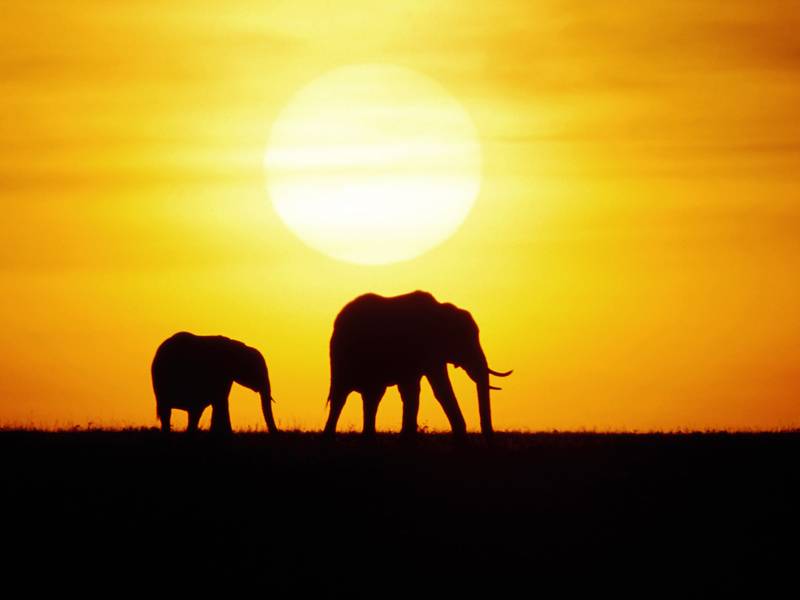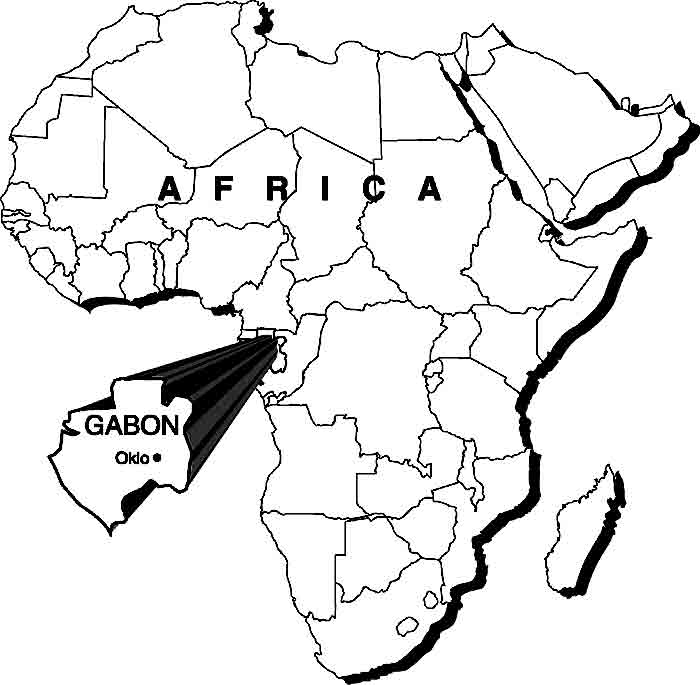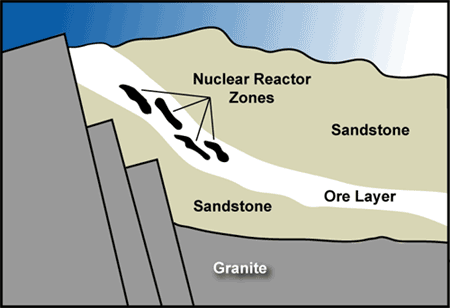One of Africa's Wealthier Countries
Natural Nuclear Reactor in Oklo, GabonPeople go to Africa and confirm what they already have in their heads and so they fail to see what is there in front of them. - Chinua Achebe
Source: globemonnaies.free.fr byJames Lovelock "A bizarre consequence of the appearance of oxygen was the advent the world's first nuclear reactors. Nuclear power from its inception has rarely been described publicly except in hyperbole. The impression has been given that to design and construct a nuclear reactor is a feat unique to physical science and engineering creativity. It is chastening to find that, in the Proterozoic, an unassertive community of modest bacteria built a set of nuclear reactors that ran for millions of years. This extraordinary event occurred 1.8 eons (1.8 billion years) ago at a place now called Oklo in Gabon, Africa, and was discovered quite by accident. At Oklo, there is a mine that supplies uranium mainly for the French nuclear industry. During the 1970s, a shipment of uranium from Oklo was founded to be depleted in the fissionable isotope Uranium-235. Natural uranium is always of the same isotopic composition - 99.27% Uranium-238, 0.72% Uranium-235 and traces of Uranium-234. Only the Uranium-235 isotope can take part in the chain reactions necessary for power production or for explosions. Naturally, the fissionable isotope is guarded carefully and its proportion in uranium subjected to thorough and repeated scrutiny. "Imagine the shock that must have passed through the French atomic energy agency when it was discovered that the shipment of uranium had a much smaller proportion of Uranium-235 than normal. Had some clandestine group in Africa or France found a way to extract the potent fissionable isotope, and were they now storing this for use in terrorist nuclear weapons? Had someone stolen the uranium ore from the mine and substituted spent uranium from a nuclear industry elsewhere? Whatever had happened, a sinister explanation seemed likely. The truth, when it came, was not only a fascinating piece of science but must also have been an immense relief to minds troubled with images of tons of undiluted Uranium-235 in the hands of fanatics. "The chemistry of the element uranium is such that it is insoluble in water under oxygen-free conditions, but readily soluble in water in the presence of oxygen. When enough oxygen appeared in the Proterozoic to render the ground water oxidizing, uranium in the rocks began to dissolve and, as the uranyl ion, became one of the many elements present in trace quantities in flowing streams. The strength of the uranium solution would have been at most no more than a few parts per million, and uranium would have been but one of many ions in solution. In the place that is now Oklo such a stream flowed into an algal mat that included microorganisms with a strange capacity to collect and concentrate uranium specifically. They performed their unconscious task so well that eventually enough uranium oxide was deposited in the pure state for a nuclear reaction to start. "When more than a 'critical mass' of uranium containing the fissionable isotope is gathered together in one place there is a self-sustaining chain reaction. The fission of uranium atoms sets free neutrons that cause the fission of more uranium atoms and more neutrons and so on. Provided that the number of neutrons produced balances those that escape, or are absorbed by other atoms, the reactor continues. This kind of reactor is not explosive; indeed it is self-regulating. The presence of water, through its ability to slow and reflect neutrons, is an essential feature of the reactor. When power output increases, water boils away and the nuclear reaction slows down. A nuclear fission reaction is a perverse kind of fire; it burns better when well watered. The Oklo reactors ran gently at the kilowatt power level for millions of years and used up a fair amount of the natural Uranium-235 doing so. "The presence of the Oklo reactors confirms an oxidizing environment. In the absence of oxygen, uranium is not soluble. It is just as well that it is not; when life started 3.6 eons (3.6 billion years) back, uranium was much more enriched in the fissile isotope U-235. This isotope decays more rapidly than the common isotope U-238, and at life's beginning the proportion of fissile uranium was not 0.7% as now but 33%. Uranium so enriched could have been the source of spectacular nuclear fireworks had any bacteria been unwise enough to concentrate it. This also suggests that the atmosphere was not oxidizing in the early Archean. "Bacteria could not have debated the costs and benefits of nuclear power. The fact that the reactors ran so long and that there was more than one of them suggests that replenishment must have occurred and that the radiation and nuclear waste from the reactor was not a deterrent to that ancient bacterial ecosystem. (The distribution of stable fission products around the reactor site is also valuable evidence to suggest that the problems of nuclear waste disposal now are nowhere near so difficult and dangerous as the feverish pronouncements of the antinuclear movement would suggest.) The Oklo reactors are a splendid example of geophysical homeostasis. They illustrate how specific materials can be segregated and concentrated in the pure state - an act of profound negentropy in itself, but also an invaluable subsystem of numerous geophysical processes. The separation of silica by the diatoms and of calcium carbonate by coccolithophoridons and other living organisms, both in nearly pure form, are such processes and have had a profound effect on the evolution of the earth. James Lovelock is the author of The Ages of Gaia (1988) Source: alamut.com
Hey! We Can Use This!
Creating a nuclear reaction is not simple. In power plants, it involves splitting uranium atoms, and that process releases energy as heat and neutrons that go on to cause other atoms to split. This splitting process is called nuclear fission. In a power plant, sustaining the process of splitting atoms requires the involvement of many scientists and technicians. It came as a great surprise to most, therefore, when, in 1972, French physicist Francis Perrin declared that nature had beaten humans to the punch by creating the world’s first nuclear reactors. Indeed, he argued, nature had a 2-billion-year head start.1 Fifteen natural fission reactors have been found in three different ore deposits at the Oklo mine in Gabon, West Africa. These are collectively known as the Oklo Fossil Reactors.2 And when these deep underground natural nuclear chain reactions were over, nature showed that it could effectively contain the radioactive wastes created by the reactions. No nuclear chain reactions will ever happen in a repository for high-level nuclear wastes. But if a repository were to be built at Yucca Mountain, scientists would count on the geology of the area to contain radionuclides generated by these wastes with similar effectiveness. Scientists from other countries were sceptical when first hearing of these natural nuclear reactors. Some argued that the missing amounts of U-235 had been displaced over time, not split in nuclear fission reactions. "How," they asked, "could fission reactions happen in nature, when such a high degree of engineering, physics, and acute, detailed attention went into building a nuclear reactor?" Calculating back to 1.7 billion years ago - the age of the deposits in Gabon - scientists realized that the U-235 there comprised about 3%. This is high enough to permit nuclear fissions to occur, providing other conditions are right.3 Deep under African soil, natural conditions had prompted underground nuclear reactions. Scientists from around the world, including American scientists have studied the rocks at Oklo. These scientists believe that water filtering down through crevices in the rock played a key role. Without water, it would have been nearly impossible for natural reactors to sustain chain reactions. The water slowed the subatomic particles or neutrons that were cast out from the uranium so that they could hit-and split-other atoms. Without the water, the neutrons would move so fast that they would just bounce off, like skipping a rock across the water, and not produce nuclear chain reactions. When the heat from the reactions became too great, the water turned to steam and stopped slowing the neutrons. The reactions then slowed until the water cooled. Then the process could begin again.4 Scientists think these natural reactors could have functioned intermittently for a million years or more. Natural chain reactions stopped when the uranium isotopes became too sparse to keep the reactions going. Once the natural reactors burned themselves out, the highly radioactive waste they generated was held in place deep under Oklo by the granite, sandstone, and clays surrounding the reactors’ areas. Plutonium has moved less than 10 feet from where it was formed almost two billion years ago.5 Today, manmade reactors also create radioactive elements and by-products. Scientists involved in the disposal of nuclear waste are very interested in Oklo because long-lived wastes created there remain close to their place of origin. The Oklo phenomenon gives scientists an opportunity to examine the results of a nearly natural two billion-year experiment, one that cannot be duplicated in the lab. By analysing the remnants of these ancient nuclear reactors and understanding how underground rock formations contained the waste, scientists studying Oklo can apply their findings to containing nuclear waste today. The rock types and other aspects of the geology at Oklo differ from those at Yucca Mountain. But this information could prove useful in the design of a repository at Yucca Mountain, should it be judged suitable for one. Were the Oklo reactors a unique event in natural history? Probably not. Scientists have found uranium ore deposits in other geological formations of approximately the same age, not only in Africa but also in other parts of the world, particularly in Canada and northern Australia. But to date, no other natural nuclear reactors have been identified. Scientists believe that similar spontaneous nuclear reactions could not happen today because too high a proportion of the U-235 has decayed. But nearly two billion years ago, nature not only appears to have created her first nuclear reactors, she also found a way to successfully contain the waste they produced deep underground.
The radioactive remains of natural nuclear fission chain reactions that happened 1.7 billion years ago in Gabon, West Africa, never moved far beyond their place of origin. They remain contained in the sedimentary rocks that kept them from being dissolved or spread by groundwater. Scientists are studying Yucca Mountain to see if the geology there might play a similar role in containing high-level nuclear waste. References1 Cowan, G A 1976. "A Natural Fission Reactor," Scientific American, 235:36. Note: In 1956 while at the University of Arkansas, Dr Paul Kuroda described the conditions under which a natural nuclear reactor could occur. When the Oklo reactors were discovered in 1972, the conditions found there were very similar to his predictions. Dr Kuroda now lives in Las Vegas, Nevada where he has been a scientific resource for the United States Department of Energy. US Department of Energy Source: ocrwm.doe.gov June 2000 See also:
For more articles relating to Money, Politics and Law including globalisation, tax avoidance, consumerism, credit cards, spending, contracts, trust, stocks, fraud, eugenics and more
click the "Up" button below to take you to the page on "How Many Countries in the World?" Clicking "Up" from there will take you to the Index for this section. |
 Animals
Animals Animation
Animation Art of Playing Cards
Art of Playing Cards Drugs
Drugs Education
Education Environment
Environment Flying
Flying History
History Humour
Humour Immigration
Immigration Info/Tech
Info/Tech Intellectual/Entertaining
Intellectual/Entertaining Lifestyles
Lifestyles Men
Men Money/Politics/Law
Money/Politics/Law New Jersey
New Jersey Odds and Oddities
Odds and Oddities Older & Under
Older & Under Photography
Photography Prisons
Prisons Relationships
Relationships Science
Science Social/Cultural
Social/Cultural Terrorism
Terrorism Wellington
Wellington Working
Working Zero Return Investment
Zero Return Investment

